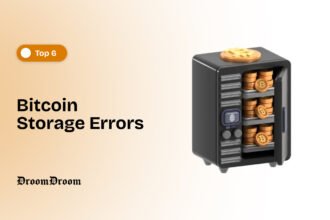The layer-2 solutions rise as the most efficient dynamos in the realm of blockchain, superseding the clunky layer-one mechanisms they supersede. Layer-1 is the base for decentralized systems, while Layer-2 is like a professional who solves problems by reducing the amount of traffic, cutting down on transaction costs, and greatly improving the capacity. Layer-2 is the astute artist who polishes and perfects the blockchain experience, taking it beyond just laying the blocks.
- How Does the Layer-2 Crypto Project Work?
- What Layer-2 Projects Should You Know About in 2026?
- How Does Layer-2 Differ from Layer-1 in Crypto?
- Advantages of Layer-2 Crypto
- Disadvantages of Layer-2 Crypto
- Security Concerns
- Interoperability Challenges
- Dependence on Layer-1 Security
- Complexity in Development
- Potential Centralization
- Conclusion
For layer-2 crypto projects are in fact solutions constructed upon underlying blockchain networks. The aim is to improve scalability, and resolve problems with the foundational chain itself. Because they run on a second layer, the term “Layer-2” is used for these projects. Their purpose is to increase rate of transaction and reduce fees as well as optimize overall network efficiency.
This time around, we have selected the best Layer-2 crypto projects that will shine in 2026. They leverage next-gen technologies aimed at improving already-established blockchains in terms of affordable and speedy payments. In this regard, these Layer-2 projects lead the frontline in realizing a newer age characterized by user experience and decentralized applications as users’ quest to demand scalable blockchains intensifies.
How Does the Layer-2 Crypto Project Work?
Layer 2 cryptocurrency projects operate as solutions that are built on top of existing blockchain networks, aiming to overcome scalability challenges that involve transacting off-chain or through a second layer. This has been done to increase efficiency, reduce costs, and unclog the main chain.
A popular pathway utilizes sidechains and state channels, two distinct systems through which transaction recording occurs outside the main chain. Such confidential transactions are done only as a private act and documented in the primary ledger only when it is essential. This substantially minimizes pressure on the main blockchain, making transactions faster and cheaper.
For example, state channels allow people to trade with each other multiple times outside of their transaction history. The last one is then put to vote on the main chain, thereby reducing fees and processing time per transaction on the chain.
Rollups are another approach used in Layer 2 projects. These include transaction bundling, with all being sent to the primary chain at once. Firstly, optimistic rollups presume that transactions are valid and need to be challenged before verification. However, zk-rollups utilize zero-knowledge proofs for transaction verification, which ensures a high level of security and, at the same time, greatly improves scalability.
For crypto newbies this article will help you know more about zero knowledge.
Blockchain scaling without sacrificing decentralization and security is possible due to the smooth connection of Layer-2 solutions. Layer-2 projects increase the scalability of the blockchain ecosystem by transferring certain processes away from the main chain and initiating interaction with the main blockchain only where necessary, thereby allowing for easier adaptation to an increased audience and varied applications. The latter contributes significantly to uncovering the whole set of possibilities for conventional block system use in mass operations.
What Layer-2 Projects Should You Know About in 2026?
Some of the major layer-2 crypto projects to look out for in terms of addressing blockchain scalability and improving user experiences in 2026 include Here are a few noteworthy projects to keep an eye on:
Optimism
Optimism is a kind of scaling solution for the Ethereum network to optimize its performance. It accelerates transaction verification and lowers fees and congestion on the Ethereum network by giving transactions the benefit of the doubt.
zkSync
zkSync is an Ethereum-based L2 scaling solution based on zk-rollups. ZkSync achieves the integrity and confidentiality of transactions that yield more scalability and minimize transactional costs. Thus, this project is part of a bigger strategy aimed at introducing enhanced scalability features for DApps and DeFi on the Ethereum platform.
Arbitrum
Arbitrum is a layer-two solution for Ethereum that leverages optimistic rollups. It seeks to offer quicker and more cost-effective transactions for decentralized applications as well as smart contracts in the Ethereum network. Arbitrum increases Ethereum’s scalability by processing most transactions off-chain and settling only when necessary on the Ethereum mainnet.
Polygon (formerly Matic)
Technically speaking, Polygon should be understood as a Layer-2 scaling framework rather than a Layer-2 solution. It includes several side chains and proposals geared towards improving scalability to facilitate the development and deployment of distributed applications on the Ethereum platform.
StarkWare
Starkware is focusing on zk-rollups to enable the scalability of Ethereum and enhance its overall performance. Börd: StarkWare concentrates on zk-rollups that allow upscaling of Ethereum as well as improving it. By using zero-knowledge proofs, StarkWare allows for batch offloading of transactions, which in turn makes an Ethereum environment scalable at low costs.
Layer-2 projects hold great importance in dealing with the scalability problems of main blockchains, helping to make a cheaper, faster, and better decentralized world.
How Does Layer-2 Differ from Layer-1 in Crypto?
Regarding scalability solutions within the blockchain environment, layers 1 and 2 pertain to distinct strategies that are designed to address issues about transaction rate, cost, and overall performance. Here’s a breakdown of their key differences:
Layer-1
On-Chain Scaling
These are often termed layer-one solutions and entail a direct change to the existing blockchain protocol. Such changes can be made to the consensus algorithm, block size, or block time. At its core, it is about scaling the underlying layer of the blockchain.
Global Consensus
Layer 1 has the largest network, and it maintains a worldwide agreement for everything. Each player validates the transaction through processing, and the parties arrive at the same condition concerning the status of the blockchain. This is the classical model you will see in most networks, including but not limited to Bitcoin and Ethereum (before the implementation of scaling solutions).
Security and decentralization
Security, scalability, and the decentralized nature of Layer-1 solutions constitute fundamental characteristics. The principle that any changes that touch the base need to keep the main features of the blockchain concept should be applied.
Layer-2
Off-Chain Scaling
They are referred to as later-2 solutions that improve layer-one transactions by having them processed outside or through another layer. This relieves pressure on the main blockchain, thereby enhancing scalability and transaction speed.
Reduced On-Chain Load
To this end, layer-2 protocols seek to reduce the number of blockchain transactions by removing some procedures outside the chain. The main blockchain is used for settling transactions only as per need, thus maximizing the efficiency of the main layer.
Consensus Variations
Different consensus mechanisms than those of the underlying Layer-1 blockchain might be adopted by some Layer-2 solutions. As a case in point, there are both optimistic rollups and zk-rollups as some of the Layer-2 solutions that follow different consent mechanisms.
Advantages of Layer-2 Crypto
Scalability
The main benefit of the layer-2 solution is that it offers scalability. Some of these solutions help to unburden the main blockchain by performing some specific transactions off-chain or through a slayer, which leads to faster and cheaper transactions.
Reduced Fees
Additionally, there is a high tendency for transaction fee reductions on layer-2 solutions. In addition, processing transactions offline would mean fewer on-chain operations, leading to lower user fees and more reasonable microtransactions.
Improved Transaction Speed
Transaction speed is improved tremendously with the help of Layer-2 solutions, as they make for a lesser load on-chain. Therefore, it reduces the time for confirmation, and this increases the network efficiency in terms of users.
Enhanced Privacy
Certain Layer-2 protocols, especially those using proof of knowledge zero-knowledge (zk-rollups), provide more security. With respect to user confidentiality, the anonymity provided by transactions done away from the blockchain makes them more personal.
Diverse Use Cases
The layer-2 solutions facilitate innovative opportunities for DApps as well as various use cases. The result is the development of advanced and user-friendly apps that lead to innovation within the blockchain sector.
Disadvantages of Layer-2 Crypto
Security Concerns
Security issues relating to layer two solutions arise. Despite attempts to keep them secure, any weaknesses or breaches in Layer 2 infrastructure put assets at risk for customers.
Interoperability Challenges
The compatibility with other blockchains of these Layer-2 solutions is difficult to achieve. However, there are no uniform protocols that might slow down communication between various blockchain systems.
Dependence on Layer-1 Security
Most of these Layer 2 solutions are built on the security of the bottom Layer 1 blockchain. Should any compromise occur on the main chain, it has the potential to affect the safety and credibility of Layer-2 protocols.
Complexity in Development
The creation and introduction of Layer-2 options can also be complicated. Developers have to be equipped with more equipment, which could even bring about a learning curve with its challenges. The complexity of these solutions may impede their acceptance.
Potential Centralization
Some of these Layer-2 solutions might be susceptible to centralization issues when there are few operators running the off-chain structure. However, striking a balance between scalability and decentralization is still hard for now.
Overall, layer 2’s benefits include faster transactions, lower costs, and scalability, but these solutions face issues involving security, compatibility, and the risk of becoming a centralized system. However, they are working on Layer-2 solutions that should make the blockchain more efficient at this point.
Conclusion
Finally, scouting the landscape of the Layer-2 crypto projects in 2026 indicates a vibrant scene in which scalability, efficacy, and user experience come first. In this domain, some of the best contenders, such as Optimistic Ethereum, zkSync, Arbitrum, Polygon, and StarkWare, demonstrate different ways of overcoming the problems that affect most blockchain systems.
The industry’s dedication towards scalability, transaction fee reduction, and enhancement of overall performance in decentralized ecosystems is manifested through these Layer-2 projects. Through utilizing technologies that include optimistic rollups, zk-rollups, and sidechains, these projects provide possibilities for the future by making the blockchain more scalable and accessible.
2026 is expected to be a defining year for layer-2 solutions, and each project plays a particular role in supporting the whole blockchain ecosystem. These include optimizing Ethereum’s scalability as well as a varied set of Layer -2 frameworks such as Polygon that ultimately open up the doors to the full realization of the potential for decentralized applications, decentralized finance, and Non-Fungible Tokens
It is important to keep abreast of happenings in the layer-2 crypto world as the crypto space changes with time. In addition to being current, these cases also lay the groundwork for a larger, more robust, and more user-friendly blockchain future environment. In 2026, Layer-2 Crypto Projects Travel To Innovation And Revolutionary Advancement Of Blockchain That Aims At Wider Adoption And Inclusion Into The Dynamics of Our Digital Life.




















